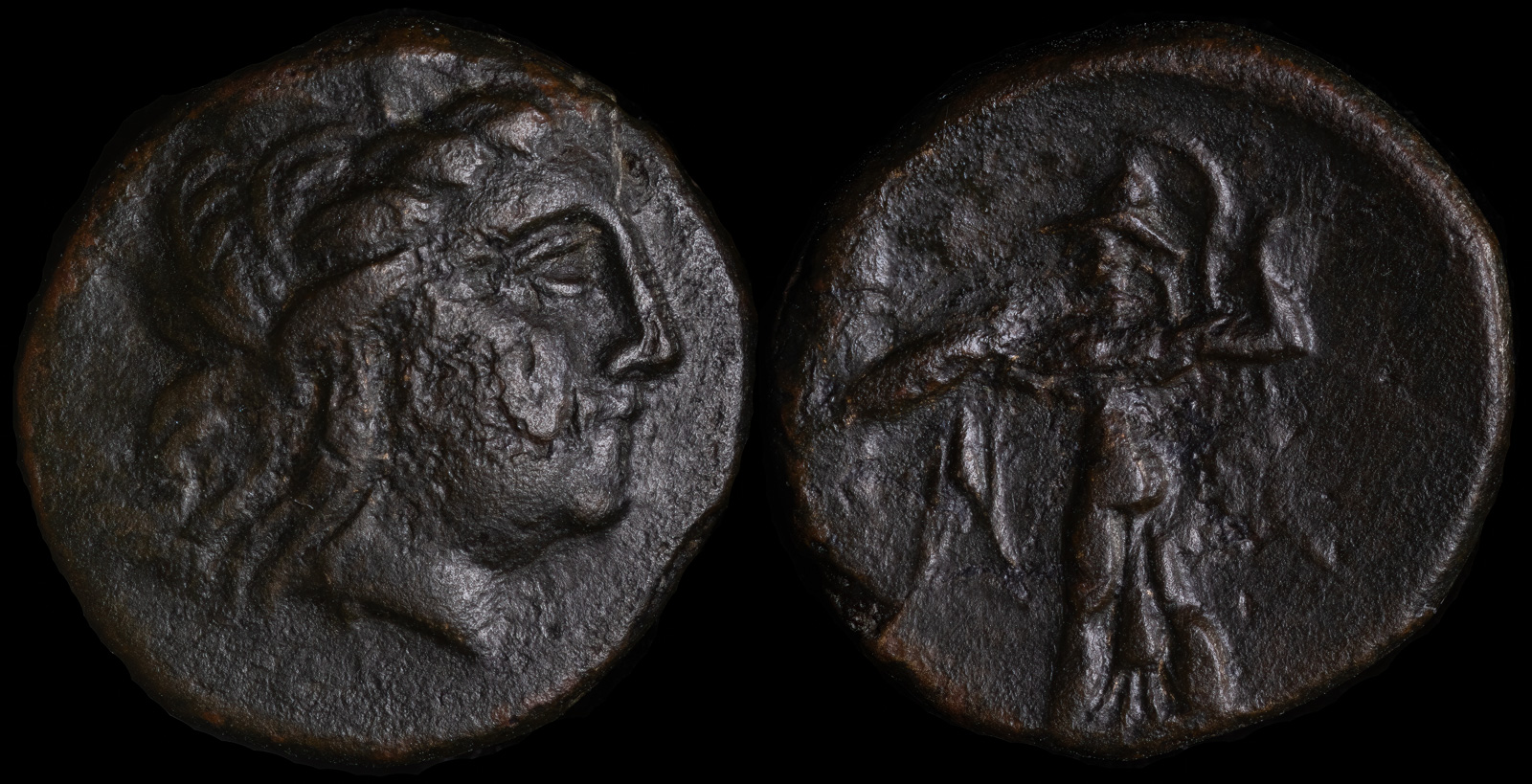
Argolis, Argos
400-350 BCE
13.56mm 1.82g
Obverse: Head of Hera left, wearing stephane
Reverse: Large A; club below
BCD Peloponnesos 1057.1
Ex BCD Collection (not in LHS sale)
Ex CNG
Ex Marc Breitsprecher
Argos was perhaps the most potent rival to Sparta in the Peloponnese. A large and powerful city, it fought against Sparta for hundreds of years and for brief period assumed hegemony over the Peloponnese.
At other times Argos was neutral, notably when the Persians invaded. Here, their neutrality provoked the ire of the other Greeks, though they were also mostly neutral in disputes between Athens and Sparta.
Although Argos was never conquered by either Philip II or Alexander III, they did have to respect their will, such as honoring a peace treaty brokered by Philip II against Sparta. Among the Diadochi, only Pyrrhos attacked Argos. He was killed in the attempt. During Pausanias’ time there was a memorial to him.
Pausanias visited and spent a great deal of his Book 2 in Argos. He details many of their temples and several stories that occurred there. For example, during one bitter dispute between Argos and Sparta, Argos raised a thousand men to attack and put a man named Bryas in charge. They made a number of raids into Lakedaimon and on one occasion interrupted a bridal possession by snatching a young girl. When Bryas fell asleep, the girl blinded him.
The soldiers then chased after the girl, who fled back the procession. When the Argives demanded the girl, the commoners refused. There was then a battle where every single one of the soldiers were killed.

Argos, Argolis
ca 280-260 BCE
Ae Dichalkon 16.3mm 3.2g
Obv: Head of Hera right wearing stephane inscribed ARGE
Rev: The Palladion standing left holding spear and shield
SNG Cop 57
Pictured on this coin is the Palladion, which was a small sacred statue that originally protected Troy. Legend had it that as long as they possessed the Palladion, the city could not be taken. Odysseus and Diomedes snuck into the city and stole the statue. Shortly thereafter, Troy fell.
After the Trojan War, one story has Diomedes returning with the Palladion to Argos, hence its depiction on the reverse.
Argos defeats Sparta at the Battle of Hysiae.
Sparta crushes Argos at the Battle of Sepeia. Sikyon participates with 12 ships.
Argos does not participate in the Greek alliance against the Persian invasion, resulting in diplomatic isolation.
Argos obtains possession of Hermione.
Argos joins an alliance with Athens and Thessaly.
Sparta defeats Athens, with 1000 hoplites from Argos, in the Battle of Tanagra. Casualties are heavy on both sides.
The alliance of Athens, Argos, and Thessaly dissolves.
Sparta and Sikyon march under King Agis against Argos, but a truce is arrived at before battle.
As a result of their loss at the Battle of Mantineia and an invasion by Epidauros, Argos undergoes an oligarchic coup.
A union between Argos and Corinth is established.
Due to the Peace of Antalkidas, the union between Corinth and Argos is broken under pressure from Sparta.
Artaxerxes III Okhos finally succeeds in re-conquering Egypt under Nektanebo II, with the help of mercenaries from Argos, Thebes, and Mentor of Rhodes.
Melos and Kimolos dispute the ownership of the island Polyaigos. The turn to Argos to mediate, who decide in favor of Kimolos.
326 BCE
Demetrios Poliorketes seizes Epidauros, Sikyon, Corinth, Bura, Argos, and Orchomenos.
Pleistarchos is expelled from Argos.
Pyrrhos of Epiros attacks Argos, which is helped by Antigonos II, and is killed there when an old woman throws a brick on him.
Antigonos II installs the tryant Aristippos the Elder at Argos.
The Nemean Games are transferred to Argos from Nemea (in Kleonai), though some events continued to be held in Nemea.
Aratos of Sikyon takes the Acrocorinth and frees Argos. Xenon steps down in Hermione.
The Spartans under King Kleomenes III defeat the Achaian League under Aratos of Sikyon (and including Argos and Megalopolis) in the Battle of Dyme.